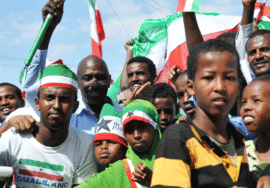In 1517, the conquest of Egypt by Sultan Salim I and its incorporation into the Ottoman Empire initiated the early intrusion of foreign powers into Somaliland. The Red Sea was free of the Portuguese after forty years. A Turkish garrison was established in Zeyla, but Berbera remained unoccupied. Yemen’s Imam of Sanaa assumed control of Zeyla following the 1663 retraction. During all this period, Berbera maintained its independence.
Berbera appears to have first come to the attention of the British in 1825. Britain’s East India Company was expanding its holdings in India at this time. The Mary Anne, with Captain Linguard at the helm, stopped at Berbera in April of that year, supposedly to trade. However, the locals attacked him when he landed. Casualties included a passenger, a crew member, and a wounded second officer. Thanks to some local help, Captain Linguard’s group managed to get onto the Duria Dowlat and travel to Aden.
Two King’s ships, Tamar and Pandora, and the East India Company’s Amherst sailed to Berbera under British orders to avenge the locals’ actions. Upon reaching Berbera, the British attacked the locals, compelling the Habr Awal tribal Sheikhs to sign a treaty on 6 February 1827, which stipulated compensation for Linguard’s losses and the bereaved families.
The treaty obligated the Sheikhs to maintain peace with Britain, grant British ships unrestricted access to their ports, and receive reciprocal privileges in British harbors. The symbolic gesture of equality was pointless; the Sheikhs lacked the means to ship goods to British ports.
The British were progressively enlarging their empire across seas. Their interest in Somaliland grew following their occupation of Aden on 19 January 1839. One year later, Captain Moresby, the British Political Agent in Aden, was dispatched to secure the Mocha Sharer’s consent for a treaty with Zaila’s Governor. Two treaties were the outcome of his visit. A meeting occurred with the Shareef of Mocha on 1st September 1840, followed by another with the Governor of Zaila on 3rd September 1840.
The British became significantly interested in Tadjoura and Zaila following their 1840 purchase of the islands guarding the harbors’ entrances. These islands, infamous for their slave trade history, remained unoccupied. They served as the main trading route for southern Abyssinia.
By 1840, the British Government had received reports of a Boudreaux (France) expedition sailing to Zaila. The British, concerned about other powers settling on the African coast near Aden, instructed their Aden Political Agent to establish and maintain British influence amongst the local population. A government directive specifically tasked the Political Agent with acquiring a harbor-commanding station in Tajoura. Captain Moresby and Lieutenant Barker were charged by the Political Agent with securing the Sultan of Tadjoura’s signature on a treaty transferring the Mussa Islands to British control. A successful treaty signing occurred on 19 August 1840, thanks to the two officers. The islands officially became a British possession on 31 August 1840. According to the treaty, Sultan Mahomed bin Mahomed had to seek approval from British authorities at Aden before forming any alliances with other European countries. He also consented to refrain from supporting any pact detrimental to Britain.
The 1847 attempt by Muscat’s Imam to claim Berbera through an emissary was rejected by the Somalis. The Imam received tribute from the Majeerteen clan Somalis, as reported by Lieutenant Cruttenden following his April visit to the coast.
In late 1851, a British official in Aden reported tribal conflict that caused the Berbera trade to shut down. Britain discovered a letter from Sheikh Ali Shermarke, the Governor of Zaila, to Turkish authorities in Hudeida, suggesting Berbera’s transfer to the Turkish flag, which was problematic.
In late March 1852, a British vessel from Aden was attacked near Berbera. The British held Sheikh Ali Shermarke’s squadron responsible for the attack. The boat owner demanded compensation from him, plus a Rupees 500 fine for disrespecting the British flag. Shermarke requested the fine’s dismissal. Lieutenant Cruttenden, the Assistant Political Agent at Aden, worried the Pasha of Yemen would be angry about the fine imposed on Shermarke, a Turkish subject. Captain Haines, the Political Agent, reported Shermarke’s actions were solely his responsibility, not those of any Turkish or other governing body, as Shermarke was Somali-born, not Turkish.
An 1854 mission, the Somali Expedition under Lieutenant Richard Burton, investigated the land between Berbera and Zanzibar. A report from Lieutenant Burton (22 February 1855) stated that Sheikh Shermarke, a Chief, had obtained Zaila and Tadjoura from the Turks through a rental agreement. Burton stated that Shermarke’s ultimate goal was to raise the British flag in Tadjoura and Zaila. He portrayed the Sheikh as a benevolent leader who kept Zaila peaceful.
Richard Burton’s account of his time in Zaila (October 27-31 November 1854), published in his 1856 book “First Footsteps in East Africa”, notes the Governor, El Haji Shermarke bin Ali Salih, as rather remarkable. By his account, he’s a sixteenth-generation descendant of Ishak El Hazrami, the revered founder of the influential Garhajis and Awal tribes. He further suggested a British Agency in Berbera, a proposal Brigadier-General Coghlan, Aden’s British Resident, strongly backed, aiming to secure daily supplies vulnerable to Arab attacks. On 19 April 1855, Burton’s Mission was attacked, resulting in the death of Lieutenant Croyan. Britain blockaded Berbera’s port as punishment for the alleged crime, believing this would compel the chiefs to hand over Croyan’s supposed murderers. The “murderers” were not surrendered by the Chiefs. The blockade concluded on 9 November 1856, following a British-Chiefs treaty. The commercial interests of the parties involved were secured by this treaty, as with the earlier one.
The British valued Berbera highly as a source of fresh provisions for their Aden garrison. The British authorities worried about a possible disruption of their supplies at any time. The Political Resident reported that the territory’s tribes were experiencing internal strife. It was a place where, “every man has his share; the assembly is a democracy without laws and regulations of any kind.”
Somaliland commercial activity with Aden centered on ghee exports. The Periplus of the Erythreaen Sea states that Somali butter clarification, a skill acquired through 1st-century Indian imports, was exported in the 19th century by the same ships. Even in the tropics, ghee will remain usable for hundreds of years. Burton’s account (First Footsteps in East Africa, pp. 136 and 247) reveals that contemporary caravans endured six-week or longer journeys in Somaliland’s intense heat. Lieutenant Cruttenden’s description of the Berbera Fair included modern ships full of ghee, in jars, bought in Somaliland for trading purposes.
As World War II concluded, the Somalilanders formed the active Somaliland National Society (SNS). The group consisted of diverse, educated, and experienced Somalilander business owners from the town. Smaller parties that started in the early 1930s, with minimal pre-war impact, were assimilated. The Somaliland Protectorate government forbade civil servants from joining political parties; however, many were secretly involved or showed sympathy. A 1946 merger united them with the Somali Transport Company (STC), a self-help group under Mohamed Jama Urdoh’s leadership. The group restructured in 1951, adopting the name Somali National League (SNL) and establishing political goals: Somali unification, socio-economic progress, and ending tribal conflict.
The NUF, formed in 1955 by Somalis in British Somaliland, wasn’t initially a political party; its purpose was to pressure Britain to overturn the Haud and Reserved Area’s transfer to Ethiopia. The NUF’s political framework allowed for input from various groups, including SYL, SNL, and the Somali Officers’ Union, which represented civil servants.
To protest Ethiopia’s land acquisition, the NUF dispatched a Protectorate-wide representative delegation to Britain, then the UN. Michael Mariano led the delegation. The NUF later developed into a self-governing political party. Leadership of the NUF fell to Michael Mariano; Mohamed Ibrahim Egal led the opposing Somali National League.










